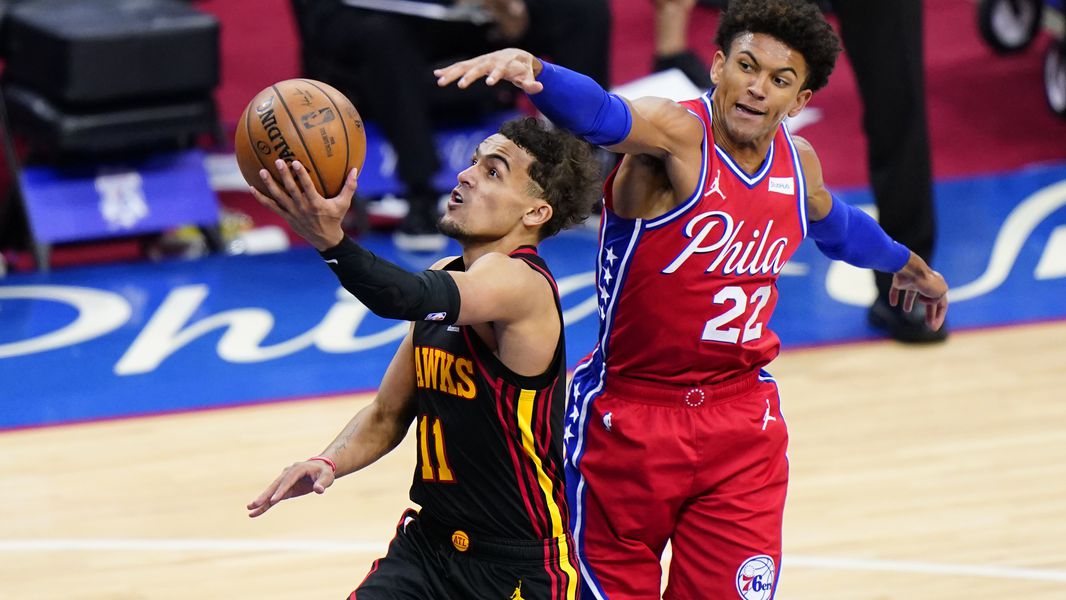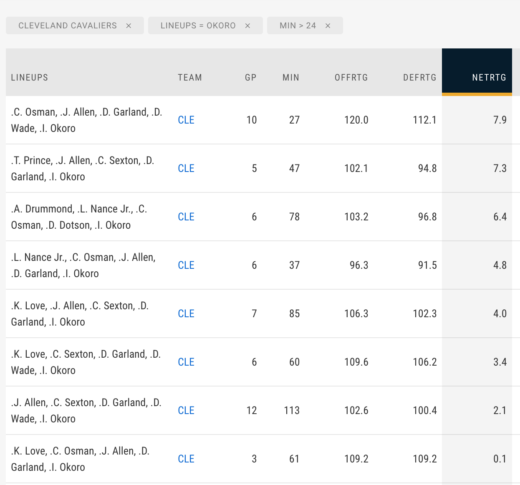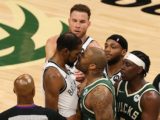
Open Thread: Conference Semis (Bonus: Roster Review, Shooting Guard edition)
2021-06-17Hello CtB!!!
We continue with the Roster Review series, looking at the Cavs’ shooting guard position. Let’s dive in…
Isaac Okoro
As General Manager Koby Altman said in his end of season press conference, the biggest takeaway of the season was collecting data on the young core, and the Cavs were able to collect a massive amount of data on Isaac “Ice” Okoro. So what did the Cavs find out? Well, the first thing the Cavs should’ve realized is that Okoro is not a “3 and D” small forward. Okoro struggled with such a role, shooting an abysmal 29% from three and being one of the worst rebounders in the NBA (7% defensive rebound rate, 3rd percentile in the NBA). And while the tape shows Okoro with tons of basketball IQ on the defensive end especially in isolation situations, his 6’5″ length just isn’t enough to bother the better scoring/playmaking wings in the NBA (-1.1 dEPM, 28th percentile in the NBA).
So what did Okoro do well? Well, when JB Bickerstaff had to juggle lineups due to injury, he tried some Okoro at the shooting guard position (and even some instances of Point Okoro), and as a result, Okoro looked like a completely different player. With the ball in his hands, Okoro displayed flashes of playmaking (15.2 assist ratio, nearly equal to Collin Sexton) and an ability to make good decisions with the basketball for a rookie (12% turnover percentage, 45th percentile in the NBA). Also, Okoro improved his ability to finish at the rim from abysmal to below average (57% field goal percentage at the rim, 37th percentile in the NBA). Isolating Okoro’s stats post-All Star break and over the past 15 games, one could argue that Okoro outplayed Sexton from a decision making standpoint (over the last 15 games, Okoro 2.31 assist to turnover ratio, Sexton 1.61), as well as from a defensive standpoint (over the last 15 games, Cavs’ defensive rating while Okoro was on the court 116.2, Sexton 121.1).
To close the Okoro discourse, there are some interesting trends in the five man lineup data. The two trends that stand out are that three out of the top four Okoro five man lineups are with Okoro as the shooting guard. Also, two out of the three best Okoro five man offensive lineups are with Okoro as the shooting guard. Disclaimer: the lineup data is scrubbed to only show Okoro five man lineups with greater than 24 minutes of court time.

Dylan Windler
While Windler is classified by various outlets as a shooting guard, Basketball Reference indicates that he split his time almost equally at the shooting guard and small forward positions. Watching the games this season, it’s clear that he lacked the foot speed to guard on the perimeter (-1.5 dEPM, 17th percentile in the NBA) and was much better suited as a front court off-ball defender, showing legitimate NBA defensive playmaking abilities (1.8% steal rate, 70th percentile in the NBA, and 2.0% block rate, 64th percentile in the NBA). The defensive playmaking metrics are an encouraging sign that Windler can process the NBA game fast enough to stick.
The real problem for Windler this past season is processing the game on the offensive end. His decision making was clearly very poor (18% turnover percentage, 7th percentile in the NBA). Also, Windler had a concerning issue getting his three ball off (33% 3pt field goal percentage, 29th percentile in the NBA). His shooting percentages inside the arc obviously shows a guy who has great shooting touch (63% field goal percentage at the rim, 47% field goal percentage in the midrange). It’s clear that Windler’s inability to stay healthy has hampered his growth grasping the mental side of the game, and now he’s going into his age 25 season next season. If Windler wants a chance to stick in the NBA, his ideal role will be as a backup “3 and D” small forward. He has clear limitations guarding the perimeter and making plays on the ball and off the dribble.
Damyean Dotson
Damyean Dotson started off the year well with some good minutes at the backup shooting guard position, but as the year went on and Dotson had to fill in as the fifth (or thereabout) string point guard, his lack of playmaking and three ball really became apparent. It should be said that JB’s inability to bring some type of consistency to his minutes and role negatively impacted Dotson’s play. A couple of positives on Dotson’s year was his ability to be effective as a scorer inside the arc (68% field goal percentage at the rim, 44% field goal percentage in the midrange) as well as putting forth a professional effort on the defensive end (-1.0 dEPM, 31st percentile in the NBA).



#WojBomb
https://twitter.com/oldseaminer/status/1405877223903608837?s=20
Seems decent for Boston. Walker’s knees are shot, and he’s owed a crap ton of cash. Seems like they need to move a big now, though. Maybe TT.
IDK, Horford is owed $20-$30 million less over the next two years than Kemba. Likely meaning they can keep Fournier. And Al can space the floor while TT cannot. And Al is healthy while Kemba is not.
I’d take healthy Horford + Fournier over injured Kemba + 16th pick.
OKC will take the pick & look to move Kemba on.
good points Jason — maybe the whole point is to bet on Fournier?
Nate I have popped this tweet into a new post on the trade
Bucks at Nets game 7 is gonna be interesting. With Kyrie out, and Harden limited, the Bucks SHOULD win.
But Middleton is the only Bucks shooter I trust. And I do not trust them not to do dumb things. Or coach Bud to put Giannis on Durant if KD gets going.
Harris finally hits some triples. Harden is a tad better. KD goes for 35+. Nets win. God I hope I am wrong.
why in the world is Giannis not guarding KD? I just cannot for the life of me figure it out, if the Bucks lose and KD goes supernova again on PJ Tucker Bud is a goner….
Yeah. He is the only guy KD cannot just shoot over. Put Giannis on KD and Tucker/Lopez on Griffin. Not all game, but clutch time.
Giannis better not shoot a three in game 7 unless it’s just to beat the clock…
LMFAOOOOOOOo game 7s are wacky!!!
Well bucks got this.
Safe to say…
Lol…Middleton Hardened Harden…
Giannis is mostly playing his best game tonight. The game he should be playing every night.
LMFAOOO yup zero three point attempts.
Harden is just falling to the floor every shot, looking for the flop call. Heart of a warrior.
LMFAOOOOOOOO
Harden’s flop game is on point despite the bad hammy. Respect.
https://twitter.com/SethPartnow/status/1405710500843986944?s=20
LMFAOOOOOO Bud sucks!!!! and Holiday can’t score either.
They are misusing Holiday. Best when he is driving in fast, defense collapses & he kicks out or pocket-passes. He should not be lobbing long range.
yup, fortunately he still plays great defense and seems to have found his finishing touch.
So it would appear Griffin’s 3 pt performance in the first game is going to be an outlier…
Same with Jeff Green…
The NBA should construct a monument commemorating this era of basketball. It would be a statue of a guy setting a pick on the perimeter, illegally shoving the defender as the ball handler throws up a wild shot to get the foul call.
LMFAOOOOOOOOOO
Nice to see Unca Jeff isn’t shooting like prime Steph Curry so far. I may not need to throw this brick through my tv screen after all.
Harden pretty obviously hampered physically. Another game where he’ll be playing three arc to three arc, and try to ride Durant for 40+…
Bucks pretty sharp offensively out of the gate. Question is, as always, will they be sharp if/ when crunch time comes.
the betting was weird on the game. Smart bet was taking the Bucks @ -5.5, which was insane to me.
CONGRATULATIONS ICE!!!!!!!
https://twitter.com/ShamsCharania/status/1405677407131086848?s=20
Okoro absolutely deserves the mention. He was so good post All Star game.
He gathered momentum for sure. Great to see he is being acknowledged.
Interesting. I think Okoro could skyrocket next season. I’ve already bought all the Garland/ Okoro stock. I’d be more than okay seeing Okoro/ Garland getting big minutes at the guard spots.
Yeah, as I was doing Okoro research, one thing that stood out was how good Garland was at the end of the year, and how bad Sexton was at the end of the year in terms of impact stats. Just dragging down the team with his abysmal effort on the defensive end.
+++